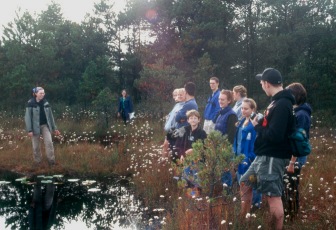
|
|||||||||||
EVSC
200: Introduction to Environmental Science
 EVSC 200 students on field trip to Burns Bog. |
Theme: The role of science in developing solutions to a mix of global and local environmental problems. Brief Description: This role will be illustrated through discussions of several past, current, and emerging environmental issues. These discussions will also be used to explore, in the specific context of environmental studies, key aspects of both science and the scientific method. These will include, e.g., the fate of chemicals released into the environment, and the role of experimentation vs. modeling. The following specific issues will be explored: |
- pollution problems associated with DDT, PCB’s, phosphates, and dioxins and furans,
- greenhouse gas emissions and global warming,
- potential impacts of forestry on caribou and salmon,
- other human impacts on Pacific salmon,
- biodiversity and exotic species,
- environmental standards for industry, and
- impacts of environmental change on human health.
Course Organization: The lectures will explore these environmental issues, developing associated scientific concepts and principles, and demonstrating the role of scientists in developing solutions. Weekly tutorials (starting in the second week), assigned readings, compositions, and quantitative exercises will provide opportunities for students to familiarize themselves with these ideas in a more active way. Two field trips will also be organized. There will, in addition, be a mid-semester test and a final examination.
Field Trips: Tentative destinations for the field trips are (i) the Squamish area and (ii) Burns Bog. These field trips will be strictly optional. They will be organized as car pools. (i) The Squamish area is world-renowned for its overwintering eagle population, wind surfing, and rock climbing. Humans have also extracted copper, trees, salmon and hydroelectric power from the area. It is furthermore becoming an increasingly popular place to live. The field trip will focus on some of the conflicts surrounding these multiple uses. (ii) Burns Bog is a unique part of our natural heritage. We shall hike into the heart of the bog, exploring along the way the natural ecosystem with its unique bog vegetation, floating peat mats, and bog ponds.
Required Work: Students will be required to participate in laboratory-style exercises, excursions, and discussions in tutorials, and to submit one or two exercises in Excel, a short, written critique, and an essay. There will also be a mid-semester test and a final examination. Both will be closed-book, and both will involve a combination of short-answer questions and other problems involving fuller explanations.
Evaluation: The weighting scheme for determining final percent scores will be as follows:
- Debates/Presentations 5%
- Excel Exercise(s) 5%
- Critique 5%
- Essay 15%
- Mid-semester Test 20%
- Final Examination 50%
Letter Grades: Final percent scores will then be converted to letter grades using the following criteria:
- A: Solid grasp of virtually all concepts and a strong ability to manipulate them in novel applications.
- B: Good understanding of the bulk of the material. Some ability to use the concepts in novel applications.
- C: Basic understanding of the course material, but substantial weaknesses that need to be addressed if the ideas are to be useful at a later stage.
- D: Minimally acceptable performance. Major deficiencies that must be addressed before continuing in the area.
- F: Unacceptable
performance.
Unless other arrangements are made, compositions and exercises will be returned in the tutorials, the mid-semester test will be returned in a subsequent lecture, and the final grades will be posted by student number outside the instructor’s office. Students wishing to make alternative arrangements to further protect confidentiality should consult the instructor.